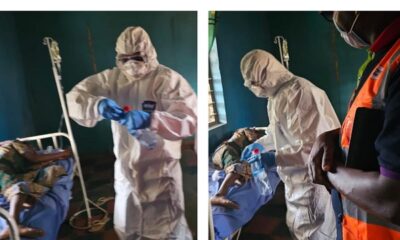Health
More women, children survive today than ever before – Report
More women and their children are surviving today than ever before, according to new child and maternal mortality estimates released yesterday by United Nations groups led by UNICEF and the World Health Organization (WHO).
Since 2000, child deaths have reduced by nearly half and maternal deaths by over one-third, mostly due to improved access to affordable, quality health services.
“In countries that provide everyone with safe, affordable, high-quality health services, women and babies survive and thrive,” said Dr Tedros Adhanom Ghebreyesus, Director-General of WHO. “This is the power of universal health coverage.”
Still, the new estimates reveal that 6.2 million children under 15 years died in 2018, and over 290 000 women died due to complications during pregnancy and childbirth in 2017. Of the total child deaths, 5.3 million occurred in the first 5 years, with almost half of these in the first month of life.
Women and newborns are most vulnerable during and immediately after childbirth. An estimated 2.8 million pregnant women and newborns die every year, or 1 every 11 seconds, mostly of preventable causes, the new estimates say.
Children face the highest risk of dying in the first month, especially if they are born too soon or too small, have complications during birth, congenital defects, or contract infections. About a third of these deaths occur within the first day and nearly three quarters in the first week alone.
“Around the world, birth is a joyous occasion. Yet, every 11 seconds, a birth is a family tragedy,” said Henrietta Fore, UNICEF Executive Director. “A skilled pair of hands to help mothers and newborns around the time of birth, along with clean water, adequate nutrition, basic medicines and vaccines, can make the difference between life and death. We must do all it takes to invest in universal health coverage to save these precious lives.”
Vast inequalities worldwide
The estimates also show vast inequalities worldwide, with women and children in sub-Saharan Africa facing a substantially higher risk of death than in all other regions.
Levels of maternal deaths are nearly 50 times higher for women in sub-Saharan Africa and their babies are 10 times more likely to die in their first month of life, compared to high-income countries.
In 2018, 1 in 13 children in sub-Saharan Africa died before their fifth birthday– this is 15 times higher than the risk a child faces in Europe, where just 1 in 196 children aged less than 5 die.
Women in sub-Saharan Africa face a 1 in 37 lifetime risk of dying during pregnancy or childbirth. By comparison, the lifetime risk for a woman in Europe is 1 in 6500. Sub-Saharan Africa and Southern Asia account for around 80% of global maternal and child deaths. Countries in conflict or humanitarian crisis often have weak health systems that prevent women and children from accessing essential lifesaving care.
Progress linked to universal health coverage
The world has made substantial progress in reducing child and maternal mortality. Since 1990, there has been a 56% reduction in deaths of children under 15 years from 14.2 million deaths to 6.2 million in 2018. Countries in Eastern and South-Eastern Asia have made the most progress, with an 80% decline in under-five deaths.
And from 2000 to 2017, the maternal mortality ratio declined by 38%. Southern Asia has made the greatest improvements in maternal survival with a nearly 60% reduction in the maternal mortality ratio since 2000.
Belarus, Bangladesh, Cambodia, Kazakhstan, Malawi, Morocco, Mongolia, Rwanda, Timor-Leste and Zambia are some of the countries that have shown substantial progress in reducing child or maternal mortality. Success has been due to political will to improve access to quality health care by investing in the health workforce, introducing free care for pregnant women and children and supporting family planning. Many of these countries focus on primary health care and universal health coverage.
Health
Oyo: Tragedy As Bride-to-Be Among Four Dead in Suspected Lassa Fever Outbreak
The Oyo State Ministry of Health has closed two hospitals in Saki West Local Government Area following a suspected outbreak of Lassa fever, which has claimed four lives.
The fatalities, confirmed by the Oyo State Rapid Response Team (RRT), include three males and a 32-year-old female who was preparing for her wedding. The closure of the hospitals aims to contain the spread of the disease and ensure thorough decontamination.
In a press statement issued by the Commissioner for Information and Orientation, Dotun Oyelade, the State Commissioner for Health, Dr. Oluwaserimi Ajetunmobi, revealed that the RRT was dispatched to Saki following distress calls from residents reporting mysterious deaths.
Findings and Immediate Actions
The RRT, comprising health officials, representatives from WHO and the Red Cross, and local health authorities, conducted a comprehensive investigation into the outbreak.
Preliminary findings suggest that an apprentice at one of the affected hospitals, who had recently returned from Iwajowa Local Government Area, might have introduced the infection.
The team disclosed that the deceased exhibited symptoms consistent with Lassa fever, such as craniofacial bleeding. The hospital owner, who was among the deceased, initially self-medicated with antimalarials and antibiotics before seeking hospital care when his condition worsened.
Containment Measures
Both the hospital where the fatalities occurred and the facility that admitted the hospital owner were shut down for decontamination.
Contact tracing efforts are ongoing, focusing on high-risk individuals who had contact with the deceased during their illness or burial.
Affected health workers were trained on Infection Prevention and Control (IPC) protocols, and public awareness campaigns were conducted to educate residents about Lassa fever.
Samples have been collected from a symptomatic individual, pending laboratory confirmation. Line-listing of contacts is underway to identify potential cases and prevent further spread.
Collaborative Efforts
The RRT also paid an advocacy visit to the Okere of Saki’s palace to brief traditional authorities on the situation. Local government officials in Saki West were engaged to coordinate containment strategies.
Reports indicate that while the outbreak initially affected Saki West, it has extended to Iwajowa and Kajola Local Government Areas.
Disease Surveillance and Notification Officers (DSNOs) in the affected LGAs have been instructed to commence preliminary containment measures as the State RRT ramps up its response.
Call for Vigilance
The Ministry of Health has urged residents to remain vigilant, report any symptoms suggestive of Lassa fever, and adhere to preventive measures.
These include proper hygiene practices, avoiding contact with rodents, and seeking medical attention promptly if symptoms arise.
Health
Oyo: Oseni to Launch Mobile Clinic Initiative to Revitalize Rural Healthcare
A member representing Ibarapa East/Ido federal constituency of Oyo State at the House of Representatives, Engr. Aderemi Oseni, has announced a plan to launch a “Mobile Clinic” programme aimed at providing essential healthcare services directly to rural communities across the constituency.
Scheduled to begin in the first quarter of 2025, this initiative underscores Oseni’s commitment to expanding healthcare access, particularly for underserved populations.
Speaking on Saturday at the 10th-anniversary celebration of God’s Knot Hospital in Ologuneru, Ibadan, the lawmaker, who also chairs the House Committee on the Federal Roads Maintenance Agency (FERMA), highlighted the programme’s primary objective: bringing healthcare closer to the people.
“Every community deserves attention; healthcare should never be bound by geographical barriers,” Oseni stated.
He explained that the mobile clinics would deliver essential health check-ups, screenings, and preventive care in remote areas, allowing residents to access quality healthcare without traveling long distances.
As part of his broader healthcare agenda, Oseni informed, through a statement by his media aide, Idowu Ayodele, that he has already facilitated the construction of two fully equipped maternity centers within his constituency, both slated for commissioning before December 2024. He also disclosed plans to establish two modern general hospitals in 2025, further strengthening his commitment to building a healthier community.
The lawmaker expressed interest in collaborating with God’s Knot Hospital on the mobile clinic project, calling for partnerships to support sustainable healthcare initiatives that enhance the quality of life for vulnerable populations in the constituency.
“I resonate deeply with the mission of God’s Knot Hospital,” Oseni shared, adding that such partnerships would significantly improve healthcare in Oyo State”.
The anniversary event attracted distinguished guests, including former Ondo State Governor Dr. Olusegun Mimiko, whom Oseni commended for his contributions to healthcare, particularly through the Mother and Child Hospitals that transformed maternal and child healthcare in Ondo State.
Oseni urged philanthropists, government bodies, and international organizations to support healthcare projects like the upcoming mobile clinics, emphasising that the improvement of healthcare services is a shared responsibility.
Health
NAFDAC Shuts Maiduguri Market Over Sun-Dried Drugs After Flood
The National Agency for Food and Drug Administration and Control (NAFDAC) has ordered the immediate closure of the Gomboru drug market in Maiduguri following severe flooding that submerged the area and contaminated the drugs sold within the market.
In a statement posted on its official X handle, NAFDAC disclosed that the decision was made after reports surfaced that contaminated drugs, which had been washed and sun-dried for resale, were being sold at the market.
“After the recent flooding in Maiduguri that submerged the Gomboru drug market where contaminated drugs were washed and sun-dried for resale, the @DGatNAFDAC ordered the immediate closure of the market to conduct a thorough shop-to-shop removal of these compromised drugs,” the agency wrote.
The flooding, which ravaged Maiduguri, was triggered by the rupture of the Alau dam on the Ngadda River, located 20 kilometers (12 miles) south of the city.
The floodwaters claimed at least 30 lives and displaced 400,000 residents, leaving large parts of the city and surrounding areas in devastation.
NAFDAC’s intervention is aimed at safeguarding public health by preventing the sale and consumption of contaminated drugs.
The agency has mobilized teams to inspect the market and ensure the removal of all compromised pharmaceutical products.
-



 Politics6 days ago
Politics6 days agoOyo Rep. Member, Akinmoyede Appoints Three More Aides
-



 Crime & Court1 week ago
Crime & Court1 week agoEFCC Chair Raises Alarm on Rampant Fraud in Nigeria’s Electricity Sector
-



 Health7 days ago
Health7 days agoOyo: Tragedy As Bride-to-Be Among Four Dead in Suspected Lassa Fever Outbreak
-



 Politics5 days ago
Politics5 days ago#OndoDecides2024: Rep Oseni Hails Aiyedatiwa’s Victory, Commends Residents for Peaceful Polls